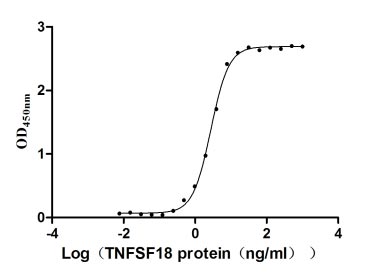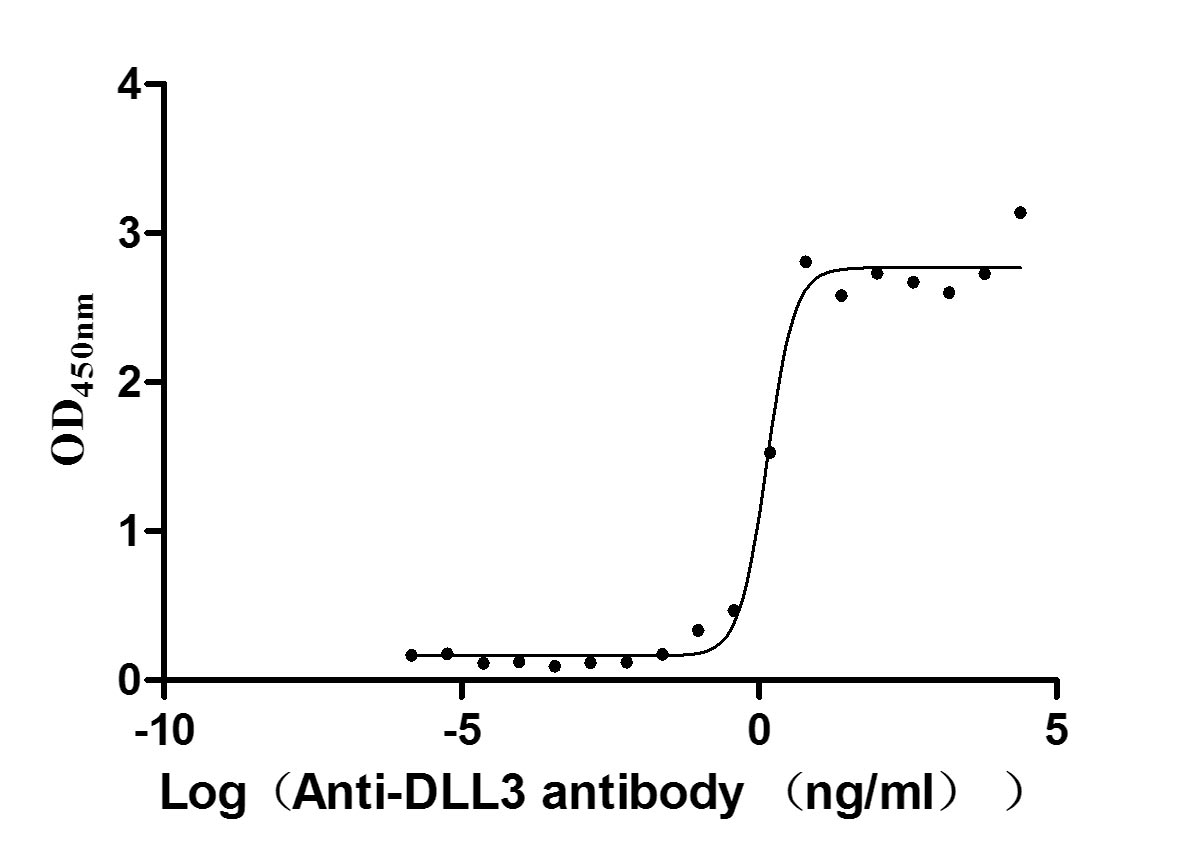Recombinant Human Small glutamine-rich tetratricopeptide repeat-containing protein alpha (SGTA)
-
货号:CSB-YP021204HU
-
规格:
-
来源:Yeast
-
其他:
-
货号:CSB-EP021204HU
-
规格:
-
来源:E.coli
-
其他:
-
货号:CSB-EP021204HU-B
-
规格:
-
来源:E.coli
-
共轭:Avi-tag Biotinylated
E. coli biotin ligase (BirA) is highly specific in covalently attaching biotin to the 15 amino acid AviTag peptide. This recombinant protein was biotinylated in vivo by AviTag-BirA technology, which method is BriA catalyzes amide linkage between the biotin and the specific lysine of the AviTag.
-
其他:
-
货号:CSB-BP021204HU
-
规格:
-
来源:Baculovirus
-
其他:
-
货号:CSB-MP021204HU
-
规格:
-
来源:Mammalian cell
-
其他:
产品详情
-
纯度:>85% (SDS-PAGE)
-
基因名:SGTA
-
Uniprot No.:
-
别名:Alpha SGT; Alpha-SGT; AlphaSGT; hSGT; SGT; Sgt1; SGTA; SGTA_HUMAN; Small glutamine rich protein with tetratricopeptide repeats 1; Small glutamine rich tetratricopeptide repeat containing protein alpha; Small glutamine rich tetratricopeptide repeat TPR containing alpha; Small glutamine rich tetratricopeptide repeat-containing protein; Small glutamine-rich tetratricopeptide repeat-containing protein alpha; Stg; UBP; Vpu binding protein; Vpu-binding protein
-
种属:Homo sapiens (Human)
-
蛋白长度:Full length protein
-
表达区域:1-313
-
氨基酸序列MDNKKRLAYA IIQFLHDQLR HGGLSSDAQE SLEVAIQCLE TAFGVTVEDS DLALPQTLPE IFEAAATGKE MPQDLRSPAR TPPSEEDSAE AERLKTEGNE QMKVENFEAA VHFYGKAIEL NPANAVYFCN RAAAYSKLGN YAGAVQDCER AICIDPAYSK AYGRMGLALS SLNKHVEAVA YYKKALELDP DNETYKSNLK IAELKLREAP SPTGGVGSFD IAGLLNNPGF MSMASNLMNN PQIQQLMSGM ISGGNNPLGT PGTSPSQNDL ASLIQAGQQF AQQMQQQNPE LIEQLRSQIR SRTPSASNDD QQE
-
蛋白标签:Tag type will be determined during the manufacturing process.
The tag type will be determined during production process. If you have specified tag type, please tell us and we will develop the specified tag preferentially. -
产品提供形式:Lyophilized powder
Note: We will preferentially ship the format that we have in stock, however, if you have any special requirement for the format, please remark your requirement when placing the order, we will prepare according to your demand. -
复溶:We recommend that this vial be briefly centrifuged prior to opening to bring the contents to the bottom. Please reconstitute protein in deionized sterile water to a concentration of 0.1-1.0 mg/mL.We recommend to add 5-50% of glycerol (final concentration) and aliquot for long-term storage at -20℃/-80℃. Our default final concentration of glycerol is 50%. Customers could use it as reference.
-
储存条件:Store at -20°C/-80°C upon receipt, aliquoting is necessary for mutiple use. Avoid repeated freeze-thaw cycles.
-
保质期:The shelf life is related to many factors, storage state, buffer ingredients, storage temperature and the stability of the protein itself.
Generally, the shelf life of liquid form is 6 months at -20°C/-80°C. The shelf life of lyophilized form is 12 months at -20°C/-80°C. -
货期:Delivery time may differ from different purchasing way or location, please kindly consult your local distributors for specific delivery time.Note: All of our proteins are default shipped with normal blue ice packs, if you request to ship with dry ice, please communicate with us in advance and extra fees will be charged.
-
注意事项:Repeated freezing and thawing is not recommended. Store working aliquots at 4°C for up to one week.
-
Datasheet :Please contact us to get it.
相关产品
靶点详情
-
功能:Co-chaperone that binds misfolded and hydrophobic patches-containing client proteins in the cytosol. Mediates their targeting to the endoplasmic reticulum but also regulates their sorting to the proteasome when targeting fails. Functions in tail-anchored/type II transmembrane proteins membrane insertion constituting with ASNA1 and the BAG6 complex a targeting module. Functions upstream of the BAG6 complex and ASNA1, binding more rapidly the transmembrane domain of newly synthesized proteins. It is also involved in the regulation of the endoplasmic reticulum-associated misfolded protein catabolic process via its interaction with BAG6: collaborates with the BAG6 complex to maintain hydrophobic substrates in non-ubiquitinated states. Competes with RNF126 for interaction with BAG6, preventing the ubiquitination of client proteins associated with the BAG6 complex. Binds directly to HSC70 and HSP70 and regulates their ATPase activity.; (Microbial infection) In case of infection by polyomavirus, involved in the virus endoplasmic reticulum membrane penetration and infection via interaction with DNAJB12, DNAJB14 and HSPA8/Hsc70.
-
基因功能参考文献:
- evidence that the interaction can mediate the association of Rpn13 and SGTA in a cellular context. PMID: 27827410
- Coimmunoprecipitation studies indicated that non-glycosylated tetherin is stabilized through the formation of a ternary SGTA/Vpu/tetherin complex. Although the results do not provide support for a physiological function of SGTA in HIV-1 replication, they demonstrate that SGTA overexpression regulates tetherin expression and stability, thus providing insights into the function of SGTA in endoplasmic reticulum translocation PMID: 27103333
- study demonstrates a critical role of Hsc70 in SV40 endoplasmic reticulum-to-cytosol penetration and reveal how SGTA controls Hsc70 to impact this process PMID: 28356524
- the binding of SGTA to Rpn13 enables specific polypeptides to escape proteasomal degradation and/or selectively modulates substrate degradation. PMID: 26169395
- data suggest that SGTA regulates the cellular fate of a range of hydrophobic polypeptides should they become exposed to the cytosol. PMID: 25179605
- Data show that molecular chaperone BAG6_ubiquitin-like domain (UBL) and ubiquitin-like 4A UBL4A_UBL compete for the same binding site on N-terminal dimerisation domain of SGTA protein (SGTA_NT). PMID: 25415308
- SGTA overexpression may be involved in the pathogenesis of breast cancer which might serve as a future target for novel treatment in breast cancer. PMID: 25027991
- Our data suggest a role for SGTA at distinct steps in the chaperone-dependent modulation of androgen, glucocorticoid, and progesterone receptor activity. PMID: 24753260
- SGTA depletion decreased cyclin A and cyclin B levels. PMID: 23839012
- A role of SGTA in Non-Hodgkin's lymphoma (NHL) cell proliferation, adhesion and drug resistance, and it may pave the way for a novel therapeutic approach for cell adhesion-mediated drug resistance in NHL. PMID: 24974147
- High expression of SGTA in esophageal squamous cell carcinoma correlates with proliferation and poor prognosis. PMID: 23939810
- Univariate analysis showed that the low SGTB expression was associated with poor prognosis (P<0.001) PMID: 24195513
- showed a significant increase in the AR:SGTA ratio in cancerous lesions compared to patient-matched benign prostatic hyperplasia tissue PMID: 23740762
- High Small glutamine-rich tetratricopeptide repeat-containing protein alpha expression is associated with non-small-cell lung cancer tumorigenesis. PMID: 23857189
- SGTA is present in human ovaries and has the potential to modulate androgen receptor signalling, but it may not be differentially expressed in polycystic ovary syndrome. PMID: 23433514
- SGTA recognizes a noncanonical ubiquitin-like domain in the Bag6-Ubl4A-Trc35 complex to promote endoplasmic reticulum-associated degradation. PMID: 23246001
- Structures of the Sgt2/SGTA dimerization domain with the Get5/UBL4A UBL domain reveal an interaction that forms a conserved dynamic interface. PMID: 23142665
- Homodimerizaion of SGTA is dependent on the structural integrity of amino acids 1-80, and a core evolutionary conserved peptide within this region (amino acids 21-40) necessary for an effect of SGTA on the activity of the androgen receptor. PMID: 22693264
- A BAG6/SGTA cycle operates during protein maturation and quality control in the cytosol. PMID: 23129660
- findings show that the HERV-K(HML-2) Rec protein binds to hSGT and interferes with its role as a negative regulator of the androgen receptor (AR), resulting in enhanced AR activity PMID: 22733359
- small glutamine-rich protein/viral protein U-binding protein (SGT/UBP) is a cochaperone that negatively regulates Hsp70. PMID: 12482202
- interaction with the ubiquitin-dependent endocytosis motif of the growth hormone receptor PMID: 12735788
- Complete backbone assignments of the 121 residues of hSGT were determined and deposited in BMRB 5709. PMID: 12815268
- SGT is a new pro-apoptotic factor PMID: 15710426
- CSP modulates G protein function by preferentially targeting the inactive GDP-bound form of G alpha(s) and promoting GDP/GTP exchange; the guanine nucleotide exchange activity of full-length CSP is regulated by Hsc70-SGT PMID: 15972823
- the sub-cellular localization of SGT was closely associated with Hsp90beta and apoptosis PMID: 16580629
- Interaction of hSGT with Hsc70, Hsp70 or Bag-6/Bat-3/Scythe was demonstrated in prometaphase, thereby suggesting a possible role for complexes containing hSGT and distinct (co)-chaperones during mitosis. PMID: 16777091
- For SNP rs1640262, homozygotes for minor allele were protected against PCOS. Haplotype 1 (G-A-T) associated with increased risk of PCOS. In PCOS, haplotype 2 (A-G-C) associated with increased insulin resistance, resulting in increased insulin secretion. PMID: 18332089
- The recombinant human small glutamine-rich tetratricopeptide-repeat protein SGT has been purified and crystallized and preliminary analysis of the tetratricopeptide-repeat (TPR) domain is reported. PMID: 18607086
- The TPR domain of SGT can bind Vpu and reduce the amount of HIV-1 virus p24, which is the viral capsid, secreted from cells transfected with the HIV-1 proviral construct. PMID: 18759457
- SGTA acts as a rheostat of androgen receptor signaling in prostate cancer PMID: 17942943
- SGTA (or hSGT) is essential for cell division. Knock down experiments show that cells with reduced levels of SGTA arrest in mitosis and die while undergoing cell division. PMID: 14729056
显示更多
收起更多
-
亚细胞定位:Cytoplasm. Nucleus.
-
蛋白家族:SGT family
-
组织特异性:Ubiquitous.
-
数据库链接:
HGNC: 10819
OMIM: 603419
KEGG: hsa:6449
STRING: 9606.ENSP00000221566
UniGene: Hs.203910
Most popular with customers
-
Recombinant Human Macrophage migration inhibitory factor (MIF) (Active)
Express system: Mammalian cell
Species: Homo sapiens (Human)
-
Recombinant Human Tumor necrosis factor ligand superfamily member 18 (TNFSF18), partial (Active)
Express system: Mammalian cell
Species: Homo sapiens (Human)
-
Recombinant Human Glypican-3 (GPC3) (G537R), partial (Active)
Express system: Mammalian cell
Species: Homo sapiens (Human)
-
Recombinant Human Delta-like protein 3 (DLL3), partial (Active)
Express system: Mammalian cell
Species: Homo sapiens (Human)
-
Recombinant Mouse Prolactin receptor (Prlr), partial (Active)
Express system: Mammalian cell
Species: Mus musculus (Mouse)
-
Recombinant Mouse Retinol-binding protein 4 (Rbp4) (Active)
Express system: Mammalian cell
Species: Mus musculus (Mouse)
-
Recombinant Human Trophoblast glycoprotein (TPBG), partial (Active)
Express system: Mammalian cell
Species: Homo sapiens (Human)
-
Recombinant Human Myosin regulatory light polypeptide 9 (MYL9) (Active)
Express system: Yeast
Species: Homo sapiens (Human)




-AC1.jpg)















